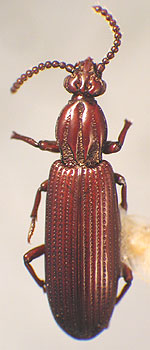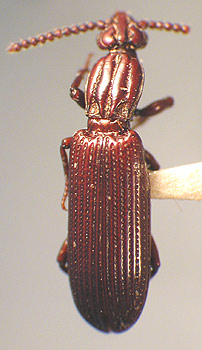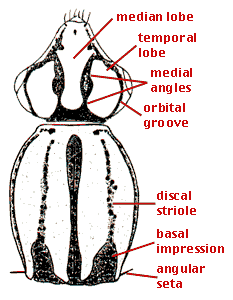Rhysodes
Ross T. Bell- Rhysodes sulcatus
- Rhysodes comes
Characteristics
The antenna has a well-developed apical stylet, and there are minor setae on antennomeres VI-X. There are four setae on the labrum. The temporal lobes are kidney-shaped and have two medial angles separated by emargination. The median lobe is narrow, and its posterior part is slightly widened. The orbital groove is complete and reaches the occiput. The pronotum has deep basal impressions which are open posteriorly. The impressions are preceded by fine discal strioles which extend 95% of the distance to the anterior margin. The pronotum has angular setae but no marginal setae. The elytron is without a humeral tubercle.
References
Bell, R. T. and J. R. Bell. 1978. Rhysodini of the World part I. A new classification of the tribe, and a synopsis of Omoglymmius subgenus Nitiglymmius, new subgenus (Coleoptera: Carabidae or Rhysodidae). Quaestiones Entomologicae 14: 43-88.
Bell, R. T. and J. R. Bell. 1979. Rhysodini of the World part II. Revisions of the smaller genera (Coleoptera: Carabidae or Rhysodidae). Quaestiones Entomologicae 15: 377-446.
Kryzhanovskij, O. L. 1983. [Coleoptera. Volume 1., part 2. Beetles of the suborder Adephaga: family Rhysodidae, Trachypachidae; family Carabidae (introductory part and revision of the fauna of the USSR).] FAUNA SSSR No.128 1983: 1-341.
Title Illustrations

| Scientific Name | Rhysodes sulcatus |
|---|---|
| Location | Adana, Asia Minor |
| Specimen Condition | Dead Specimen |
| Identified By | R. T. Bell |
| Collection | USNM |
| Image Use |
 This media file is licensed under the Creative Commons Attribution License - Version 3.0. This media file is licensed under the Creative Commons Attribution License - Version 3.0.
|
| Copyright |
© 2001 David R. Maddison

|
| Scientific Name | Rhysodes comes |
|---|---|
| Location | Kongaus, Siberia |
| Specimen Condition | Dead Specimen |
| Identified By | R. T. Bell |
| Collection | USNM |
| Image Use |
 This media file is licensed under the Creative Commons Attribution License - Version 3.0. This media file is licensed under the Creative Commons Attribution License - Version 3.0.
|
| Copyright |
© 2001 David R. Maddison

|
About This Page
Ross T. Bell

University of Vermont, Burlington, Vermont, USA
Page copyright © 2000 Ross T. Bell
All Rights Reserved.
- First online 01 March 2000
Citing this page:
Bell, Ross T. 2000. Rhysodes. Version 01 March 2000 (under construction). http://tolweb.org/Rhysodes/2236/2000.03.01 in The Tree of Life Web Project, http://tolweb.org/











 Go to quick links
Go to quick search
Go to navigation for this section of the ToL site
Go to detailed links for the ToL site
Go to quick links
Go to quick search
Go to navigation for this section of the ToL site
Go to detailed links for the ToL site